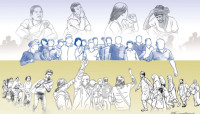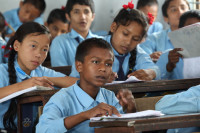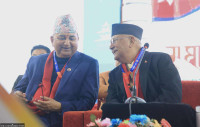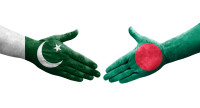Opinion
Inclusiveness in Nepal and India
There are a number of lessons that Nepal can learn from India to redress historical injustices
Mahendra P Lama
A decade-long Maoist movement in Nepal made a substantive contribution at least in highlighting the issues of the extremely alienated and marginalised populations of Dalits, Janajatis and Madhesis. They became victims only because they belonged historically to so-called lower castes, constructed an image of physical and intellectual inferiority and remained confined as a basket of geographical and social laggards. It will take a long time, sustained action and consistent commitment for the Maoists and other political parties and interest and pressure groups to prove how genuinely they are inclined to address these problems. The apprehensions arise, because like in other mainstream political parties, the top leadership in the Maoist party has a high concentration of so-called high caste individuals.
In fact, there has been no real debate and long-term vision on this crucial issue. There are emotions, political compromises and patronisation. This is what happened in India for many years. The Sachar Committee Report on Muslims in India clearly showed the negligible impact on the inclusion of Muslims in India where only Kidwais, Khurshids and Heptullahs became actors in nation’s inclusionary matrices. For decades, Nepali political parties copied exactly the inhuman tactics of exclusive patronisation pioneered by the Ranas and the Shahs in the name of empowerment and welfare to the alienated lot. But the criticality of situation that remained unaddressed for centuries demanded serious introspection, visionary policy actions and large-scale institutionalisation of inclusion as the single national socio-political agenda.
Nepali speaking Indians
Nepal has to learn much from the Nepali speaking citizens of India spread over Darjeeling, Sikkim, the north-east, Uttaranchal and Himachal Pradesh. The caste divisions among them are the same. Yet they have shown, at least in the past, tremendous robustness in practising intra-community equality. What has really made the difference is education, democratic ethos, inclusive institutions and freedom and choice in development practices. If Ratanlal Brahman became the first communist to be elected to the parliament from Darjeeling, his political foes back home included firebrand Deo Prakash Rai of the Gorkha League. In Pandit Nehru’s All India Congress Committee, one of the most trusted and acclaimed secretaries was Theodre Manen, a Gorkha dalit. LB Sewa and LB Pariyar, the much talked about IPS and IAS officers, coexisted well with Arjun Syangden, the Principal Chief Conservator of Forests, and Ram Krishna Sharma, Judge in the Calcutta High Court. The chief ministers in Sikkim were a Bhutia, a Chettri, a Gurung and a Limbu. The Gorkha National Libration Front Leader was a Tamang and the speaker in Assam Assembly was a Rai. Chokila Iyer, former foreign secretary of India, Louis Banks, noted Jazz musician and Olympiads like CS Gurung were the products of this genuine and fine practice of inclusiveness. Popular poets Agam Singh Giri cohabited with literary giants like Rup Narayan Sinha, Achha Rai Rasik and Indra Sundas.
Among the prestigious Sahitya Akademi awardees in India, an overwhelming majority are what one derogatorily calls Matwalis in Nepal. Lain Singh Bangdel, Parijat, Nirmal Lama, Amber Gurung, Man Bahadur Mukhia, Anuradha Koirala and Gopal Yonjon, who left Darjeeling in the 1960s and 1970s and brought laurels to Nepal, carried in them the righteous values of inclusiveness they imbibed in India. Nepal never seemed to have learnt from them. What today’s Nepal is clamouring for took place throughout the 20th century among the Nepali speaking communities in India. So the next responsibility of the political parties in Nepal is to introspect as to why it did not happen in Nepal. A desperate situation requires a desperate solution that involves demystification of traditional thinking and uprooting of orthodox practices.
Contentious issues in Nepal include the plight of the marginalised communities asking for the right to self determination. Does it mean federal autonomy? One sees various interpretations of this in the media and consistently inconsistent orientations and stands of political parties.
Inclusiveness anywhere has been a protracted process. Despite so much of liberal provisions in the Indian constitution, debate on other backward classes is only heating up. The Indian government regularly includes new castes and tribes in the scheduled lists. New states are being created and deeper decentralisation is made mandatory by the 73rd and 74th constitutional amendment. Just a couple of years ago, which country could boast of having the top three functionaries—the president (a Muslim with 11.67 percent of the population), the prime minister (a Sikh with 1.99 percent of the population) and the president of the ruling party/coalition (a Christian constituting hardly 2.32 percent of the population)? This is a genuine example of inclusiveness, religious-ethnic tolerance and respect for multi-culturalism. In this respect, Nepal has a long way to go. After the first President from the Madhes, the question is how long it will take for Nepal to have a Janajati prime minister and a Dalit chief justice.
India, though not a perfect example, offers a number of lessons and policy prescriptions. It now has compact and comprehensive legal and constitutional provisions aimed at inclusionary practices at various levels of governance. A set of multi-cultural, politico-legal and socio-economic institutions well spread across the geographies and communities are implementing and evaluating these policies and legal provisions. A strong judiciary and executive are there to oversee the execution of entire practices/operations. A national and local debate and discourse evolved with widespread use of the vernacular media on the criticality of such affirmative action and their implications for generations to come.
The curriculum in schools and universities incorporate in them inclusiveness as critical theme in a progressive and civilized society and the role of the state. Gradual yet steady induction of marginalised communities in the policy and decision making process, across the parliamentary bodies, bureaucracy, financial, security and justice related institutions has been done.
The responses from communities that have been subject to historical humiliation, political subjugation and social alienation have been equally heartening. The limited experience of the Indian Gorkhas does hint at four critical factors that would help the marginalised in Nepal to take maximum benefits of affirmative action and other political measures towards liberalisation that are likely to happen.
Four critical factors
First, the spread and deepening of education of all varieties—formal and informal, professional and scientific, general and academic—is key to come out of any kind of subjugation. It is access to privileged education which had been used by ‘biased’ agencies and ‘superior’ people to perpetuate the social cleavage, deprivation practices and discriminatory ethos and culture of one-upmanship.
Second, the media and the cultural, political and social institutions that advocate, fight for, monitor, and implement measures of affirmative action are the means of generating healthy, detached and informed discourses and sustained debate. Third, pushing the agenda of maximum number of representatives in the policy and decision-making bodies at the national and local levels has been of critical importance. And finally, broadening the idea of affirmative action and expanding the nature, reach, spread and scope of affirmative action have remained the core of fostering inclusiveness.
For instance, in Nepal the mere idea of reservations for the Dalits in the government service and institutions is not going to yield any substantive results. If it was done 60 years ago, the story would have been different. Today government jobs have reached a saturation level and the majority of the Dalits still remain first generation learners and outside of the so-called ‘competitive’ matrices. This inevitably calls for a level playing field, for which a basket of inclusion-related vision, action and programmes are crucial and indispensable.
Lama teaches at Jawaharlal Nehru University, New Delhi and is presently a
high end expert in the Institute of South Asian Studies, Sichuan University, China




 13.12°C Kathmandu
13.12°C Kathmandu










